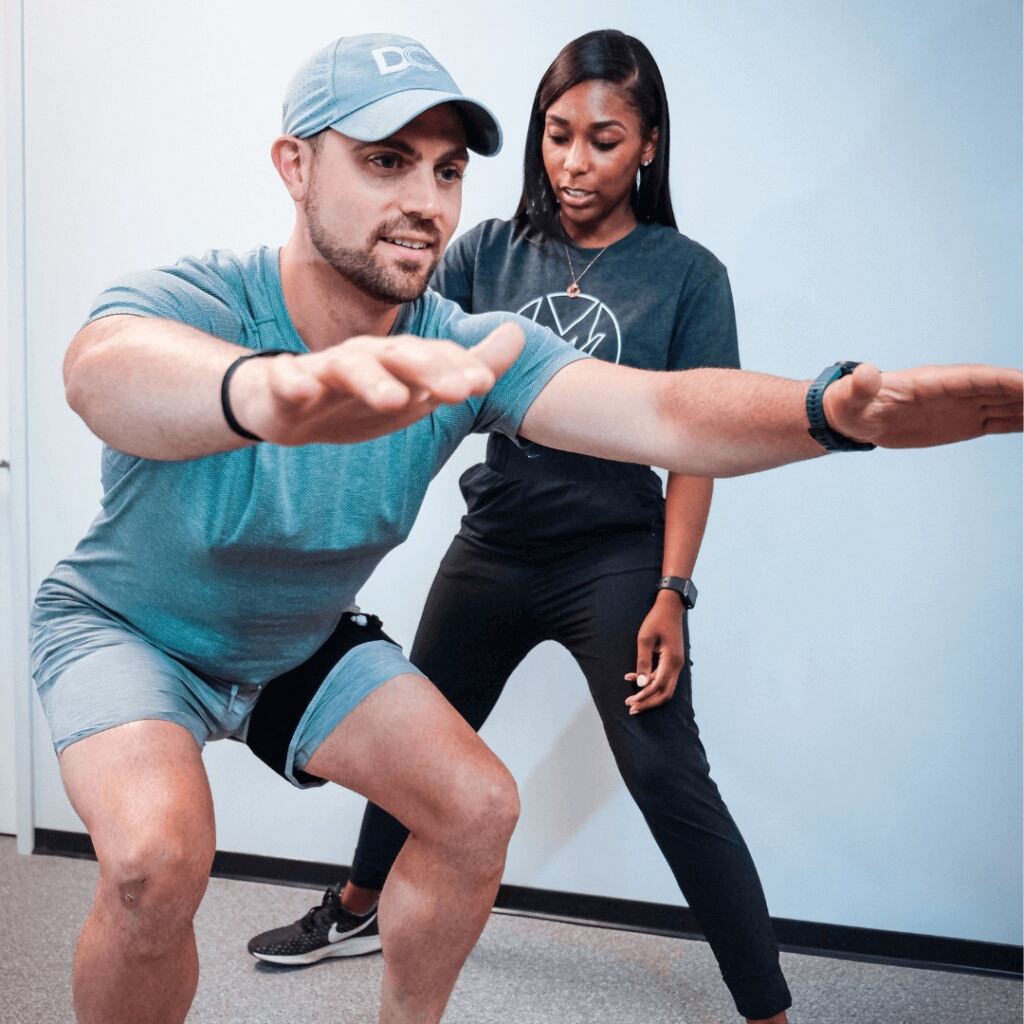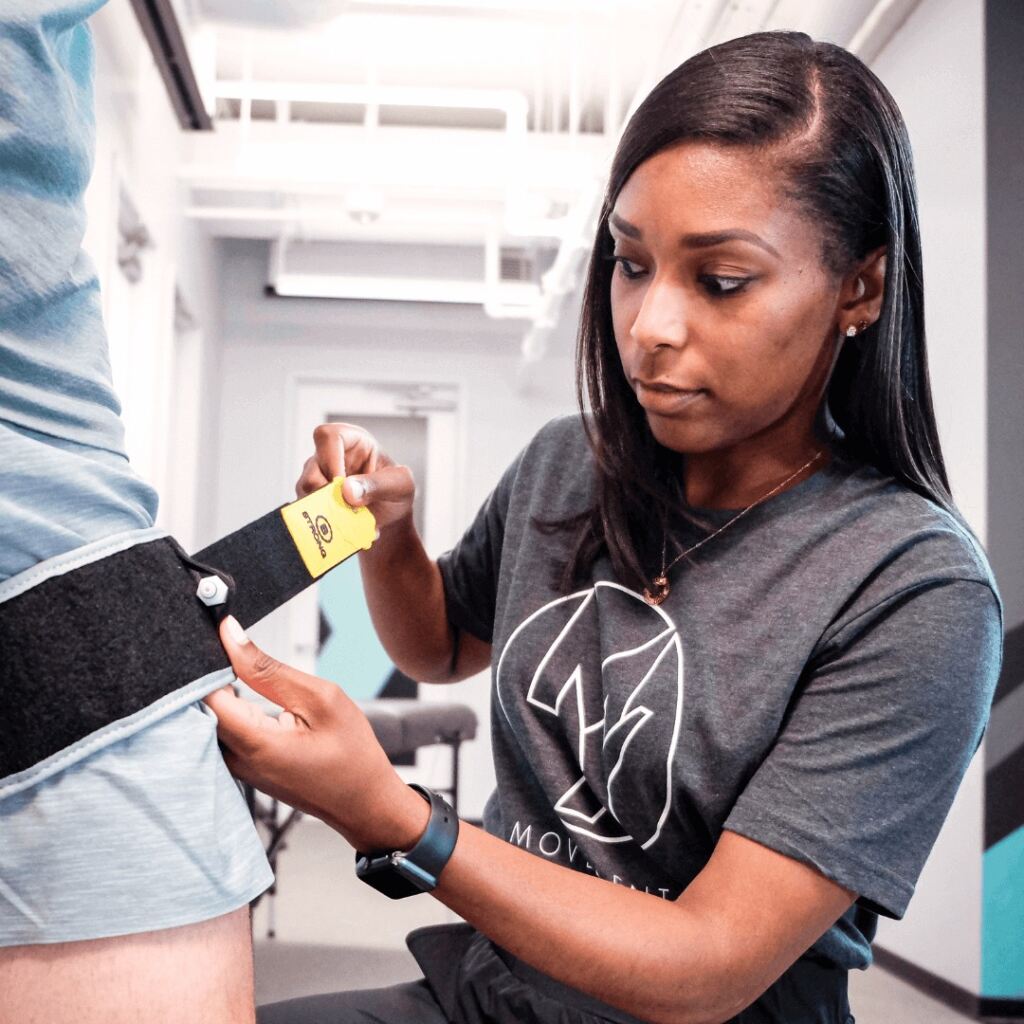Blood Flow Restriction Training – The New Americana?
Strength and big muscles are as “Americana” as football (sadly, knocking baseball off of this list) and rock ‘n roll. If I had a nickel for every time I heard my daughter argue with her friends that “my mommy is stronger than your daddy,” I could have funded my Blood Flow Restriction unit purchase..
Perfect segue…

What is Blood Flow Restriction?
Blood Flow Restriction (BFR) is a type of strength and hypertrophy (muscle growth) training that uses a cuff around the upper arm(s) or upper leg(s) to reduce blood flow going into the limbs and reduce blood flow return from the limbs.
Good news – this is not a tourniquet, so blood flow is not completely occluded.
Blood Flow Restriction (both in and out) allows for significant gains in muscle strength and size [1] while training with lighter loads than traditional strength and hypertrophy weight training programs.
When BFR is used in conjunction with an endurance program it has also been shown to improve aerobic capacity as measured by maximal oxygen uptake VO2 max (the specifics of VO2 max are beyond the scope of this article) [4].

How Does BFR work?
Short answer – While the exact mechanism(s) is yet to be determined, proposed theories abound!
A bit of context on muscle growth, in general: Brad Schoenfeld (world renowned muscle hypertrophy expert) describes three overlapping mechanisms to muscle growth (hypertrophy) – mechanical tension is most important in traditional hypertrophy programs (size and duration of loading stimulus), metabolic stress (accumulation of metabolite byproducts in response to exercise), and muscle damage (short term muscle break down induced by exercise) [1].
Put in simpler terms: hypertrophy is maximized with heavy weights and lots of reps.
While a typical high load/intensity weight training program relies heavily on the mechanical tension mechanism of muscle growth, BFR training seems to rely more on the metabolic stress pathway for muscle growth.
The current theories described in BFR literature involve some combination of the following [2]:
- Increased swelling in the muscle cells lead to metabolite accumulation and increased muscle fiber recruitment (especially the fast twitch, type II fibers, that are targeted with high load/intensity weight training). This is really important for aging populations as this fiber type is quickest to degrade with age [1].
- Increased swelling in the muscle cells leads to metabolite accumulation and upregulation of localized and systemic anabolic hormones, such as Growth Hormone and Insulin-like Growth Factor-1 (processes associated with muscle hypertrophy). This is really important for aging and injured populations.
Is Blood Flow Restriction Training Safe?
Yes (referencing 24 studies on safety of BFR [2]) – BFR is a safe training tool that does not increase risk for blood clots in the general population, nor does it increase (transiently) blood pressure as high as traditional high load/intensity weight training. Having said this, the following people should not use BFR training:
- Blood clotting disorder
- Lymphedema (in affected limb)
- Impaired circulation
- Pregnancy
Medical disclaimer: Consult your physician and physical therapist prior to starting BFR
Who should use BFR?
Anyone that is looking to improve muscle strength and size but cannot handle the high mechanical tension of resistance training [3].
Put in simpler terms: cannot handle heavy weights/lots of reps
Three target populations come to mind:
Older adults need to retard the age-related loss of muscle mass that leads to sarcopenia. According to research [1] normal adults over 60 years old have lost 10% of their muscle mass from their 20s (15% loss of muscle mass is associated with sarcopenia). While regular resistance exercise can help abate age-related muscle loss, older adults require a greater weekly minimum training dose to maintain (hopefully gain) muscle mass1 and this can be hard to achieve in conjunction with the high loads associated with typical hypertrophy training programs.
Injured population (IE: MovementX patients) that wants to stay active while recovering from the current injury that leaves their tissues unable to handle high load/intensity weight training. A key goal of any rehabilitation program is to improve tissue strength. This is a simple, but not easy goal, as it is difficult to appropriately load a tissue for strength (or hypertrophy) stimulus when a person is in pain. BFR makes this goal easier to achieve because you do not have to expose the person to heavy loads (more on this below).
Anyone trying to maximize hypertrophy (in conjunction with high load/intensity training) without overtraining. There is a fine line between overreaching (positive response to training that leads to improved performance) and overtraining (negative response that leads to exhaustion or injury) [1]. While mechanical tension (size and duration of the loading stimulus) is the most important mechanism for muscle hypertrophy [1], a common driver of overtraining is a sharp increase in workload that exceeds a person’s training history. BFR provides the duration stimulus (more on this below) and its heavier reliance on metabolic stress with minimal muscle tension/damage stress can be an effective adjunct to a hypertrophy protocol.
Who should use BFR (in simpler terms)?
People who cannot tolerate this:

***Photo credit to my 6 year old daughter
People who want to look like this:

***Photo credit to Arnold: The Education of a Bodybuilder
What is the Best Dosage for Improving Strength & Hypertrophy With BFR?
***Keys for driving a metabolic response = lots of sets/reps and light loads.
Load: 15-30% of a 1 repetition maximum for working sets. This is the beauty of BFR that makes it applicable to older/injured populations that might not tolerate high loading resistance protocols.
Set Volume: 4 sets of 30/15/15/15 repetitions
Rest periods: 30 seconds between sets
Frequency: 2-3 days a week. Due to the low loads associated with BFR, there is little/no exercise induced muscle damage and, in theory, it can be done as frequently as 1-2 x daily.
Training duration: Longer durations up to 10 weeks have the greatest positive impact on strength/hypertrophy.
Number of exercises performed with BFR: start small (1-2 per session) to assess tolerance and then build, per your personal goals.

Is BFR here to stay? Where can I go for BFR?
Research on BFR began to be published in the late 1990s after being invented by Dr. Yoshiaki Sato in 1966. As of 2018, the American Physical Therapy Association officially stated that BFR training is part of the professional scope of practice for physical therapists.
Interested in BFR to stave off sarcopenia, rehabilitate an injury, or supplement your hypertrophy protocol? Look no further than your favorite BFR MovementX provider!
***The author of this article provides BFR services (and according to his daughter, should implement the protocol more frequently in his fitness routine).
Disclaimer – The information provided is for educational purposes only and does not substitute for professional medical advice. Users should consult their medical provider for specific advice and/or treatment. The author and company are not liable for risks or issues associated with using or acting upon the information in this article.
References
- Schoenfeld B. Science and Development of Muscle Hypertrophy (2nd Edition). Champaign, IL: Human Kinetics, [2021]. Chapter 2 – Mechanisms of Hypertrophy
- Blood Flow Restriction by Owens Recovery Science (2018)
- The Drive (Podcast) #179 – Jeremy Loenneke, Ph.D.: The science of blood flow restriction—benefits, uses, and what it teaches us about the relationship between muscle size and strength (October 11, 2021).
- Foundations of Blood Flow Restriction Training. Ed Le Cara (2024)
About the Author
Dr. Dan Alcorn is a physical therapist with MovementX in Northern Virginia. He is a Board-Certified Specialist in Orthopedic Physical Therapy and is also fellowship-trained in the care for upper extremity athletes. Dan Alcorn treats patients at Patriot CrossFit in Arlington, VA, and has a strong passion for improving people’s confidence through healthier movement, lifestyle choices, and longevity.









